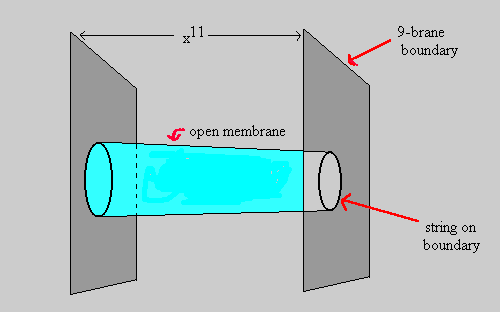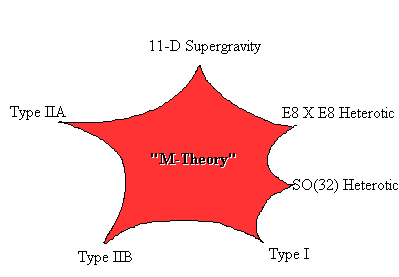

How do we know that M-theory on a circle gives the IIA superstring,
and not the IIB or Heterotic superstrings? The answer to this question
comes from a careful analysis of the massless fields that we get upon compactification
of 11-dimensional supergravity on a circle. Another easy check is that
we can find an M-theory origin for the D-brane states unique to the IIA
theory. Recall that the IIA theory contains D0,D2,D4,D6,D8-branes as well
as the NS fivebrane. The following table summarizes the situation:
| M-theory on circle | IIA in 10 dimensions |
| Wrap membrane on circle | IIA superstring |
| Shrink membrane to zero size | D0-brane |
| Unwrapped membrane | D2-brane |
| Wrap fivebrane on circle | D4-brane |
| Unwrapped fivebrane | NS fivebrane |
We can also get a consistent 10-dimensional theory if we compactify M-theory on a small line segment. That is, take one dimension (the 11-th dimension) to have a finite length. The endpoints of the line segment define boundaries with 9 spatial dimensions. An open membrane can end on these boundaries. Since the intersection of the membrane and a boundary is a string, we see that the 9+1 dimensional worldvolume of the each boundary can contain strings which come from the ends of membranes. As it turns out, in order for anomalies to cancel in the supergravity theory, we also need each boundary to carry an E8 gauge group. Therefore as we take the space between the boundaries to be very small we're left with a 10-dimensional theory with strings and an E8 x E8 gauge group. This is the E8 x E8 heterotic string!

So given this new phase 11-dimensional phase of string theory, and the
various dualities between string theories, we're led to the very exciting
prospect that there is only a single fundamental underlying theory -- M-theory.
The five superstring theories and 11-D Supergravity can be thought of as
classical limits. Previously, we've tried to deduce their quantum
theories by expanding around these classical limits using perturbation
theory. Perturbation has its limits, so by studying non-perturbative
aspects of these theories using dualities, supersymmetry, etc. we've come
to the conclusion that there only seems to be one unique quantum theory
behind it all. This uniqueness is very appealing, and much of the
work in this field will be directed toward formulating the full quantum
M-theory.

 |
 |
 |
 |